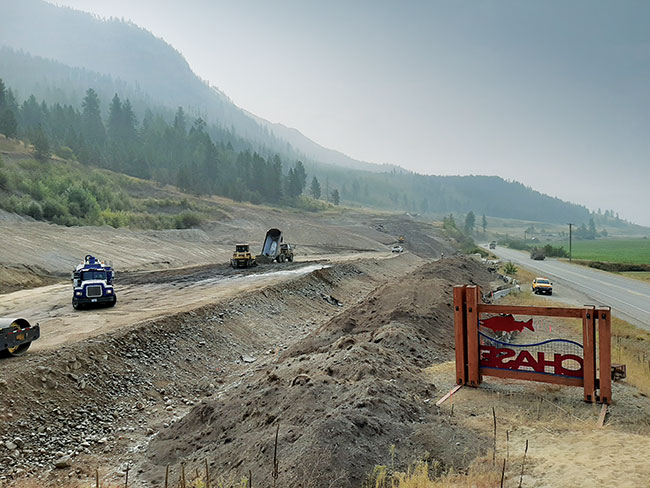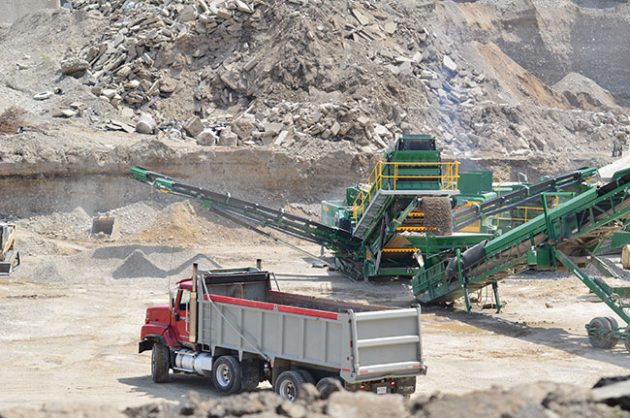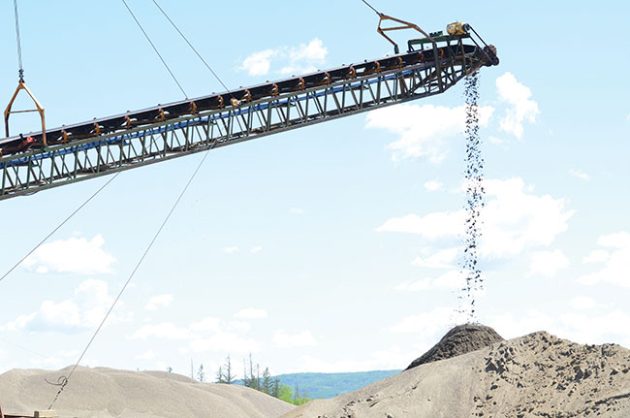
Features
Aggregates
Roads & Paving
A positive outlook for aggregate and road building
Industry optimistic about 2022
February 18, 2022 By Grant Cameron

In spite of the COVID-19 pandemic, labour shortages and supply chain issues, road builders and aggregate suppliers in most parts of the country are looking forward to a good year in 2022. The exception, however, is Alberta where it’s uncertain what the province and municipal governments are planning.
Nationwide, a number of highway and bridge construction, expansion and rehabilitation projects are planned or underway, while in British Columbia work is expected to ramp up beyond original expectations due to floods that topped dikes and washed away roads in the southwestern part of the province.
The Canada Infrastructure Bank (CIB) has earmarked $2.6 billion for subways, transit-oriented development, and commuter rail projects; and $500 million for highways, roads, bridges, tunnels and railway lines.
Specifically, $1.28 billion is for the Réseau express métropolitain (REM) light rail transit project in Montreal. Another $55 million is for planning and procurement work for a VIA Rail high-frequency rail project in the Quebec City-to-Toronto corridor. The CIB is also considering up to $2 billion in funding for a Metrolinx Go Rail expansion project in Toronto area.
The federal government also intends to invest $15 billion in transportation construction projects over the next eight years.
Meanwhile, Canada Mortgage and Housing Corporation reports in its latest Housing Market Outlook that many economic variables are expected to recover in 2022 and 2023 and starts will increase to a high of 234,500 units in 2022 and 231,900 in 2023 – both more than the anticipated figure of 230,000 in 2021.
Ontario
In Ontario, the fall economic statement notes approximately $2.6 billion is being allocated for nearly 600 highway and bridge construction projects. Part of that package includes money to advance and build the controversial Bradford Bypass and GTA West Transportation Corridor, also known as Highway 413.
Andrew Hurd, director of policy and stakeholder relations at the Ontario Road Builders’ Association, is looking for more road work to proceed this year and hopes there is funding set aside for highway projects to be done in the central region of the province, as work has been light there over the past two years.
“We really need that to rebound in the next year and we’ve communicated that,” he says. “I think we are looking for a better year than the one that was.”
Many of the scheduled projects are carry-over work from previous years and a concern is that projects are loaded up in the last two quarters of the year, says Hurd. “We understand that issues of project readiness may affect distribution between quarters but if you’re loading everything up into Q3 and Q4 that’s another year gone by. That is concerning for us.”
While COVID-19 and a shortage of labour are ongoing concerns, Hurd says another is the fact heavy equipment manufacturers are having trouble sourcing computer chips for the machines.
“We’re sort of in a holding pattern to see how that’s going to affect everything in the province and the industry as well. When it comes to the chip shortage with vehicles, it’s taking far longer to get the vehicles,” he says.
Norm Cheesman, executive director of the Ontario Stone, Sand and Gravel Association, expects a two-per-cent increase in aggregate production this year due mostly to large projects in the Greater Toronto Area.
Municipal projects have lagged due to constrained budgets caused by COVID-19 and it is very difficult to predict whether the pandemic will derail any projects but construction has been deemed an essential industry, “so from a production perspective, I see no negative impact,” he says.
The province’s continued growth due largely to immigration will continue to mean demand for infrastructure will continue, he says, noting that improvements to Highway 401 are expected to continue and when approvals are in for the Bradford Bypass it will only add to the demand for aggregates.

In Ontario, Norm Cheesman, executive director of the Ontario Stone, Sand and Gravel
Association, expects a two-per-cent increase in aggregate production this year due mostly to large projects in the Greater Toronto Area. File photo.
Quebec
In Quebec, 40 of 180 projects identified in the Quebec Infrastructure Plan to drive economic recovery were related to the roadbuilding and heavy construction sector, so the industry is expecting to be busier in 2022.
The Quebec Road Builders and Heavy Construction Association expects the volume of work in the sector to reach 39.5 million hours in 2022, up from 37.5 million in 2021.
“We therefore expect 2022 to be better in terms of investments,” notes association CEO Gisèle Bourque.
The Quebec government has increased its investments in the roads network by nearly $1 billion in 2021-22, bringing the figure to $6.42 billion. About $470 million has also been set aside for the Local Roads Assistance Program and Hydro-Québec is planning several repair projects to dams and power plants in 2022.
“With members across Quebec, entrepreneurs will help stimulate economic growth in all regions of Quebec,” says Bourque.
Several large projects are already underway in Quebec, including the $1.15-billion Hippolyte Lafontaine Tunnel, Ile d’Orléans bridge, and REM in Montreal.
Bourque says the labour shortage is a concern and the Commission de la construction (CCQ) has taken steps to attract new workers to the industry by launching a campaign and a website to promote construction jobs.
“Everything should be done to promote hiring in the industry, because employers have been hampered in the development of their business in the past,” she says. “So, the status quo is not an option.”
British Columbia
Aggregate producers in B.C. were already gearing up for a busy year because of construction of much-needed housing and infrastructure but the devastating flooding has added to the mix as roads and bridges must be repaired.
“It’s not how we wanted to be busy, for certain,” says Dani Miller, president of the BC Stone, Sand & Gravel Association. “Nobody wants to be busy because there was a disaster. But we were predicting busy before the disaster.
“There were large projects coming on with highway widening and LNG terminals and lots of big things already on the books before they realized that the dikes are probably a couple of feet shy of where they need to be. It’s definitely going to be over and above what was already predicted to be a strong year.”
Kelly Scott, president of the B.C. Road Builders and Heavy Construction Association, says 2022 looks to be a promising year for road building in the province.
“If we look at what the ministry budgets are, if we look at what the Port of Vancouver is doing, and Metro Vancouver, and TransLinks, it looks like investment will continue in B.C. for the next couple of years anyways.”
Scott anticipates the province will continue with a very aggressive budget and plan for 2022, which will be augmented with additional work for flood mitigation and repairs, “so, it will be a bump up for the industry.”
There are already plenty of projects on the go, including pipeline jobs, the new Pattullo Bridge, replacement, work along the TransCanada Highway between Kamloops and the Alberta border, and at the Ports of Prince Rupert and Vancouver, while on the horizon there is the George Massey Tunnel project.
COVID-19 has slowed some productivity in the industry, but work practices have been adapted, says Scott, and while labour is a concern, the industry has also found ways to weather such problems in the past.
“The industry has always had this capacity to adapt. Twenty years ago, they said we could never build the Olympics because we didn’t have the people. Well, we built the Olympics.
“As one industry slows down, we seem to pick up people. There is capacity in the industry for this work. You’ve got a lot of contractors around that are certainly of capacity to take on additional work as well.”

Aggregate producers in B.C. were already gearing up for a busy year because of construction of much-needed housing and infrastructure but the devastating flooding has added to the mix as roads and bridges must be repaired. File photo.
The Prairies
Chris Lorenc, president of the Manitoba Heavy Construction Association, is “cautiously optimistic” about the industry’s prospects for the next two years as there are a number of projects coming on stream.
One large project expected to get under way in 2022 is the $550-million Lake Manitoba Lake St. Martin Outlet Channels project which is in the throes of being finalized and should go to tender in spring.
However, Lorenc has concerns about what will happen after 2023 when an agreement expires between the City of Winnipeg and provincial and federal governments to invest in the regional street renewal program as roads carry most of the commercial traffic and move people to jobs and product to market.
“We’re encouraging the city to plan ahead to begin the discussions now to harness the support of business organizations that rely on moving product to and from market in the discussions.”
The previous provincial government was not particularly receptive to long-term agreements and heavy equipment contractors are hoping that Premier Heather Stefanson’s approach to working with the other levels of government and stakeholders is more progressive and collaborative, Lorenc explains.
He notes that Canada must have a proper interface of rail, road, marine facilities and ports to allow goods to be moved across the country and exported to markets overseas and ensure the economy can grow.
“That’s critical to Canada’s reputation as a reliable global trading partner and people should not underestimate how important that is. It’s one thing to be able to produce the product but if people can’t rely on your ability to move it to market, they’ll look elsewhere and do.”
In Saskatchewan, the roadbuilding and aggregates industry is expecting to see the same or slightly higher levels of construction in 2022.
“There were several major announcements made by the province in the past few months and more on the way in terms of private development and investment,” says Shantel Lipp, president of the Saskatchewan Heavy Construction Association. “We are likely to see a slight boost in earthwork in 2022.”
The government’s investment into asphalt and concrete has dropped by about $50 million for the coming season as a lot of work was completed during the last two years, so there may be a need to balance how projects are scheduled, she says, but there are still a couple of major stimulus projects to be tendered and started this year and other projects are moving forward, including the $5.7-billion BHP potash mine project.
The increase in COVID-19 is still a concern for the industry and the virus will likely result in contractors having to bid slightly higher on projects to offset those additional costs, says Lipp. The association is also working with the government and stakeholders on a training and retention strategy to bring in workers.
“Some labour shortages have been an issue, more so for the beginning of the season, and as we move into a new construction season facing a new variant of COVID-19 that may see a slight increase. Government commitment to sustained spending on major infrastructure will continue to be the boost the Saskatchewan economy needs.”
The industry outlook in Alberta, however, is uncertain. The Alberta Sand and Gravel Association is waiting to hear what the province and municipalities intend to do going forward.
“I think everyone is really, really very cautious about 2022,” says association executive director John Ashton. “We don’t have a good sense of what municipal demand will look like. We just had municipal elections and we don’t know if they’re going to go into austerity or not. We also don’t know what the provincial government is going to do.”
There was a large turnover of elected officials on municipal councils, particularly in gravel-producing municipalities, so many of the politicians are new to the scene and it’s uncertain what decisions they will make.
The aggregates industry is also waiting to hear if the government will adopt reforms suggested in the MacKinnon Report from 2019 which suggested balancing the budget by holding the line on government spending for four years, reducing operating costs by at least $600 million, and cutting capital spending.
“We still don’t know if the provincial government wants to go down that road or not, and if they do we’re in trouble as an industry,” says Ashton. “If they don’t, then we keep chugging along. So there’s that variable.”
Aggregate producers were disappointed that infrastructure was not talked about during the federal election campaign.
“Seeing what’s happening in B.C., seeing what’s happening with our drought this year and across the country, we are a place that needs to reinvest to meet the infrastructure needs of a new climate. Regardless of whether or not we do anything about climate change, it’s going to change. That horse is out of the barn, so we’re going to need to look at irrigation and flood prevention, especially in southern Alberta.”
Throughout the 2021 construction season, Alberta invested about $1.5 billion in 172 road and bridge projects. Over the next three years, the province plans to invest $2.25 billion for planning, design and construction of twinning, widening and expanding roads and building bridges. Another $1.5 billion is earmarked for capital maintenance and renewal and highway and bridge rehabilitation and replacement projects.
Atlantic Canada
In New Brunswick, the province has raised the amount for road and bridge work in its 2022 capital budget.
Tom McGinn, executive director of the New Brunswick Road Builders and Heavy Construction Association, says the government is focusing on rehabilitation and replacement of bridges and “this is making our bridge contractors happy.”
Paving work decreased in 2021 and he has yet to hear about plans for 2022.
“I would say the outlook is positive. Provincial and municipal work has been stable and it looks like both could be increased for 2022.”
The lingering effects of COVID-19 is an issue of concern going into the new year, says McGinn, as is the shortage of labour.
In Nova Scotia, the big project on the books is the continuing $718-million Highway 104 four-lane road widening project from Sutherland’s River to Antigonish. It is set for completion in August 2023.
“It adds significant volume to the overall roadbuilding activity in the province,” says Grant Feltmate, executive director of the Nova Scotia Road Builders Association.
He expects roadbuilding work in 2022 should be on par with 2021, which would mean a good year ahead.
Asphalt tonnage was a little lower than normal in 2021 but Feltmate expects it to rebound this year. Planned work on gravel and rural roads, meanwhile, has been increased.
COVID-19 has had an effect on the industry. While workers on provincial sites are already required to show a certificate of vaccination, more owners of private projects are also requiring proof of the shots.
“Therefore our contractors will all have to ensure their staff meet these requirements,” says Feltmate.
In Newfoundland, a contract valued at $9.2 million has been awarded to Trident Construction Ltd. to replace the Shoal Harbour River Bridge on the Trans-Canada Highway near Clarenville.
The work will include removal of the bridge and Shoal Harbour CNR overpass and construction of a new steel box girder bridge as well as grading and paving. The project is expected to be completed in 2023.
J-1 Contracting Limited has also been awarded a $1.67-million contract to realign the highway to the new bridge location and install a new underpass culvert.
Meanwhile, a tender has been issued for replacement of Aspen Brook Bridge on the Trans-Canada Highway in central Newfoundland.
Prince Edward Island will be investing heavily in highways, road paving and bridges in 2022-23. A $212.1-million budget approved by the province includes $72.7 million for the Department of Transportation and Infrastructure.
Over the next five years, $190 million is being set aside for road paving. It is the biggest line item in the budget.
N.W.T.
In the Northwest Territories, work has been completed on the Tłı̨chǫ Highway, a 97-kilometre all-season gravel road that connects the community of Whatì access road to Highway 3 and the national highway system all year-round. It was opened in November.
The territory and federal government are investing $50 million for construction of a new bridge to replace the Frank Channel Bridge, which has reached the end of its life. The bridge is a critical component of Highway 3.
Yukon
In the Yukon Territory, early work could begin this year on the second round of upgrades to the North Klondike Highway, a paved, two-lane road that connects Whitehorse to Dawson City.
A 110-kilometre section of the all-season thoroughfare between Carmacks and Stewart Crossing is scheduled to be rebuilt and rehabilitated over a five-year construction period.
The governments of Canada and Yukon recently announced $180 million for the project. The project is expected to create up to 800 jobs over the construction period.
Print this page